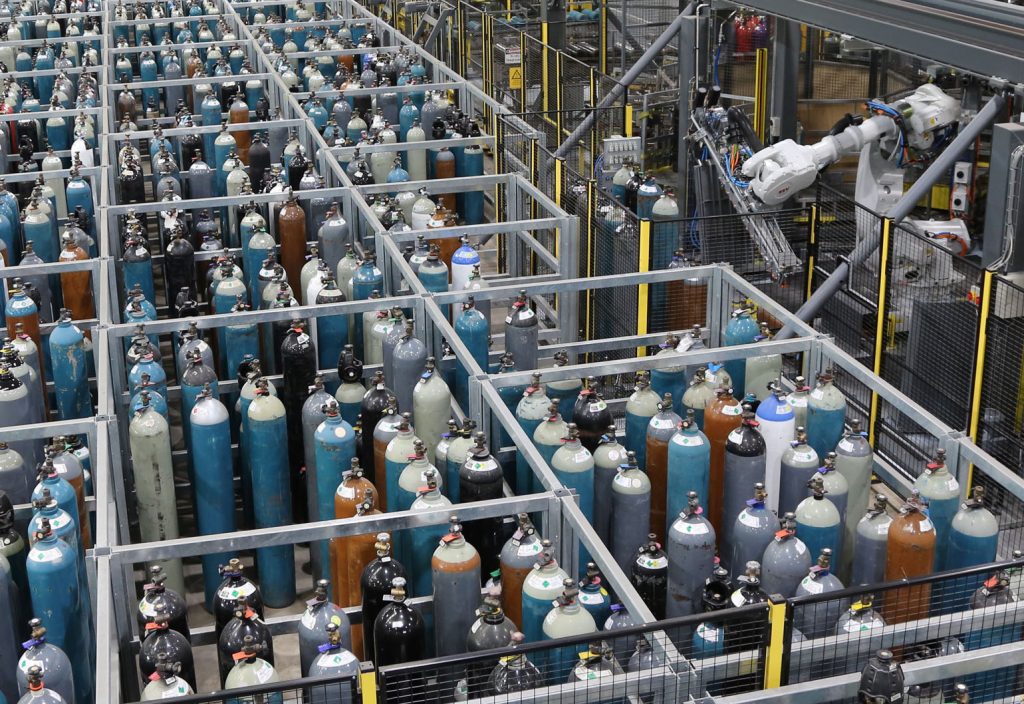BOC Australia has unveiled two new investments at its Sydney Operations Centre in Wetherill Park, including an automation system that uses a world-first application of a six-axis robot that can see, pickup and handle gas cylinders.
The system is part of two investments by the company – a $20-million specialty gases production facility and the $15-million robot cylinder automation system, which integrates advanced laser vision technologies, automated guide vehicles, robots and 3D cameras.
Derek McInerney, senior project engineer at BOC, said there are typically 15 cylinders weighing up to 120 kilograms each on distribution pallets.
When cylinders are loaded onto the pallet, they have to be manually handled into and out of the pallet.
“The difficult, repetitive nature of manually sorting cylinders places an enormous physical strain on employees. Automated sort and pick will result in a more efficient and consistent process with less injuries to our staff,” McInerney said.
The new automation system has been in development for around three years and eliminates the need for operators to manually handle cylinders and pallets, reducing the operator’s workload to merely strapping and unstrapping the pallets.
McInerney says while a different plant within The Linde Group does something similar, that plant has the advantage of a carry handle on top of the cylinders, which meant the team had to overcome the challenge of how to get a cylinder out of the pallet when there was no mechanism to actually pick it up with.
“The biggest challenge for us was we’ve got a dumb robot – a dumb six axis robot. How do we tell that robot, which is blind, to actually go and pick something from a pallet?” he said.
“Because you can program a robot to do a task, but unless it knows what the task is or what it’s actually looking to do, it won’t complete that task. So the brains behind the whole handling system is the three-dimensional laser system we developed in cooperation with a company in Finland.”
Another challenge was cylinders that were shiny – testing of the system included tests on a single cylinder in the laboratory and pointing the laser at the cylinder’s surface and looking for different degrees of reflection, with shiny cylinders proving particularly difficult.
The first prototype of the system also used a static camera system that looked directly at the pallet.
But because they weren’t scanning across the pallet, there were varying degrees of feedback from the cylinder and they couldn’t determine the correct distance from the cylinder to the actual scanner. This meant having to design a camera system that was movable.
As the team went from a static to movable camera, they realised that just having one camera was not sufficient.
“Because we’re looking with a laser beam, we’re actually looking horizontally at the pallet. We didn’t have any vertical reference for different heights, which necessitated us putting another two laser systems on the actual scanning unit,” McInerney said.
This posed additional challenges – the scanning unit became too big and couldn’t be placed on the ground because if cylinders were removed from the pallet, they would have collided with the laser scanning system. To overcome this, the team put it on a gantry overhead system.
The new automation system also involves using lasers at different predefined heights to scan a pallet so that cylinders can be mapped and display information, such as the curves of cylinders, to the automation system.
That mapping then allows operators to determine what the diameter of the cylinders are in the pallet and which cylinder is ready to come out first.
“If you have different diameters of cylinders in pallets, one cylinder may be slightly in front of the other,” McInerney said.
“But if it’s got a bigger diameter and if you select that cylinder first, it’s going to pull all the cylinders around it out before it’s actually meant to come out.”
BOC Australia’s Sydney Operations Centre produces more than 1.3 million cylinders each year, and the upgrade makes it one of the busiest production sites within The Linde Group.
The specialty gases facility will increase BOC’s capacity to locally produce and supply over 8,000 high purity and specialty gases to various industries around the country.
